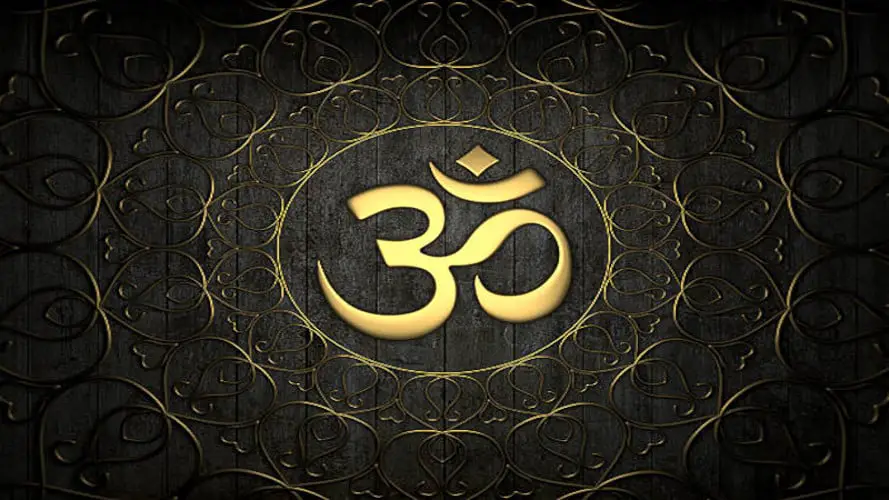The ancient symbol of ‘om’, commonly referred to as ‘the namaste symbol’, has a mysterious origin dating back thousands of years to the creation of the Hinduism, Buddhism, yoga, and the universe as a whole.
Today, you can find the Om symbol in just about every yoga studio, on yoga mats, and as an iphone emoji. It’s a symbol widely recognized with yoga, buddhism, hinduism, and meditation, but few people understand its true meaning.
As fascinating as the ‘Om symbol’ (namaste symbol) is, it’s just one of many ancient yoga symbols, and in this article we’ll explore and break down their origins and meanings.
But before we break down the meanings behind the Om symbol and other ancient yoga symbols, first we dive into the background of where yoga started to get the full ‘bigger picture‘ context from where these ancient symbols originated.
Let’s dive in.
The Origin of Yoga
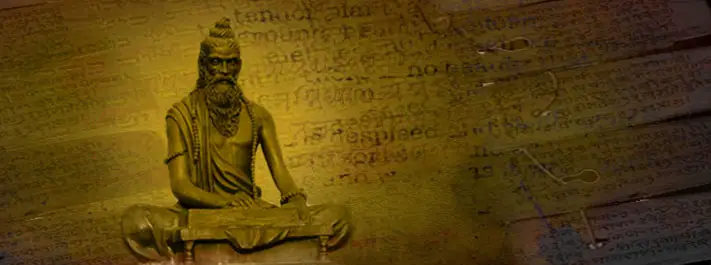
The exact origin of yoga is debated, but Yoga has been traced back thousands of years to ancient India. One of the best pieces of evidence for the origins yoga is written in The Vedas, which are a set of four texts outlining the basis of the Hindu religion.
The Vedas are written in Ancient Sanskrit and date back to 1,500 B.C (3,500 years ago).
Although the Ministry of India recognizes that the origin of yoga dates back to the Vedas period, Dr. Ishwar V. Basavaraddi (Director at the National Institute of Yoga) points out that the period between 500 BC – 800 A.D. is the time period considered to be the most “fertile and prominent” in the history and development of Yoga.
Why Was Yoga Created / Invented / Discovered ?
With origins rooted in ancient India, why did those who wrote the Vedas Texts include yoga in the sacred writings? Why was yoga discovered, invented, or created and what’s the point of doing yoga ?
In order to understand the symbols of yoga we need to look at and understand the point of yoga.
When describing the purpose of yoga, Dr. Ishwar V. Basavaraddi says that the general goal of Yoga is Self-realization. The point is to learn to live life with freedom, health, and harmony. Dr. Ishwar continues saying that “Yoga” refers to an inner science through which humans can realize a union between mind and body and achieve mastery over their destiny.
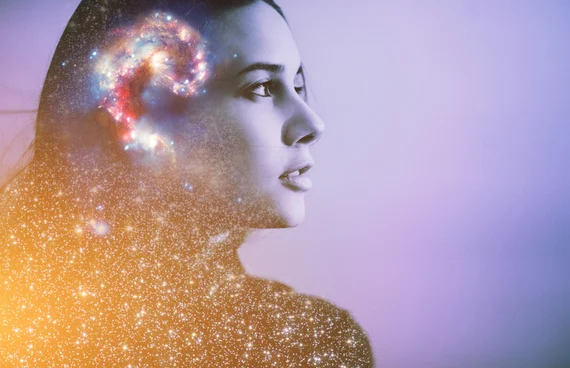
Dr Ishwar’s perspective is also backed up by world traveler, entrepreneur, and yoga teacher Christine Kaaloa.
After a stay in India to study yoga Christine‘s teacher, Lalit, made note to emphasize the point that yoga is used not to discipline the body, but to tame the mind.
Said another way, yoga’s not just about sitting on a rock cross legged twisting yourself into a pretzel, it’s about training your body to connect with your brain.
1. Align Mind, Body, Spirit
Self-alignment or internal alignment. In a recent article Mrs. Joy Smith (Founder of MaaticFlow Yoga and Wellness Inc.) sums up yoga perfectly…
When body, mind and spirit are aligned, good things happen! Through alignment we can better experience inner peace and deepened feelings of joy which are not effected by our external circumstances.
On the flip side…, when we out of alignment, our general vibe tends to feel “off” in ways that we sometimes can’t put into words.
2. Connecting To The Universe
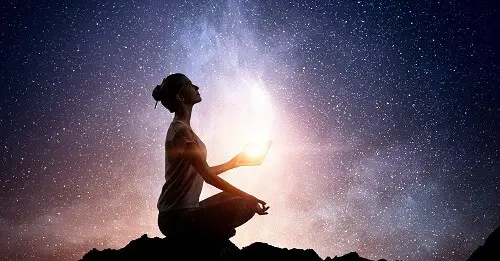
Universal alignment or external alignment. The other part of yoga deals with your alignment with the world and zooming out, with the universe. By understanding yourself and your connection to your environment and to nature, yoga helps you understand your place with-in the infinite fractal universe.
Highly respected philosophical writer Swami Krishnananda explains that yoga teaches to us that the universe is a complete organism in itself. Just like the human body. There are different parts made up of smaller parts, and smaller yet cells, but every part works together to make the whole body or universe work in totality.
Here’s a rundown of my own personal experiences using yoga to stretch and boost my overall mood.
Buddhist Yoga
Although yoga originated in India, when most people think of yoga they think it’s a Buddhist tradition. Why ?
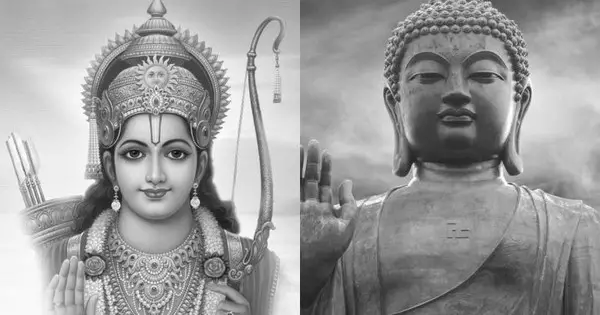
Maybe because Buddha has more mainstream appeal today? Buddha was actually born as a Prince in India in 563 B.C. But Buddha rejected the royal life and set off East towards China on a journey to find happiness.
Buddha took what he liked about India and the Hindu traditions, and left behind what the traditions he despised. He created a new way of life in Buddhism that is followed by millions of people around the world today. Many of the traditions that are commonly associated with Buddhism, were originally borrowed from the Original Vedas Texts which spawned Hinduism, including yoga.
Ancient Yoga Symbols, Origins, & Meanings
1. The “Om” (or Aum) Symbol
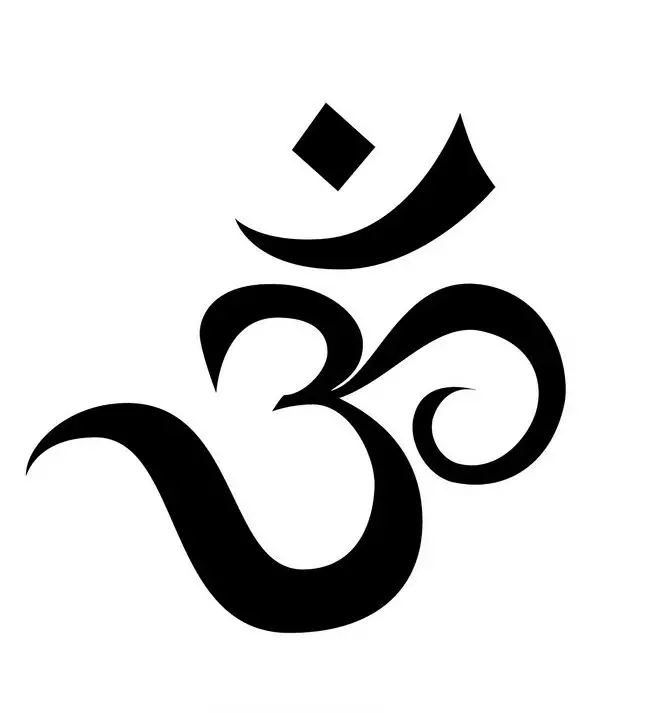
The Om symbol is commonly referred to as the “namaste symbol” or the “30 symbol” because namaste is a common yoga word, and the symbol does look like the number 30.
Although the Om (aum) symbol does look like the number 30, it’s not. The Om symbol is actually a Sanskrit word which first originated around 600 B.C. in a part of the Vedas texts known as “The Upanishads”
Om is known today as a universal symbol for yoga and for meditation, but its deeper meaning is much more profound and a bit more complex. In fact, the exact meaning of Om does not translate very well into the English language.
The meaning of Om is more of a conceptual meaning for the totality of the cosmos and the universe as a whole.
Om is said to represent the “cosmic sound” and “the universe beyond the sun”. Om is the essence of life and everything that exists. Om is considered the ultimate reality of consciousness.
Breakdown of The Om Symbol
In an article published by the National Library of Medicine in the US, Dr. Sanjay Kumar references that the meaning of Om is nothing less than the supreme state of consciousness.
Dr. Kumar’s study on “Om” also suggests that the “mental repetition of Om results in physiological alertness, and increased sensitivity to sensory transmission.”
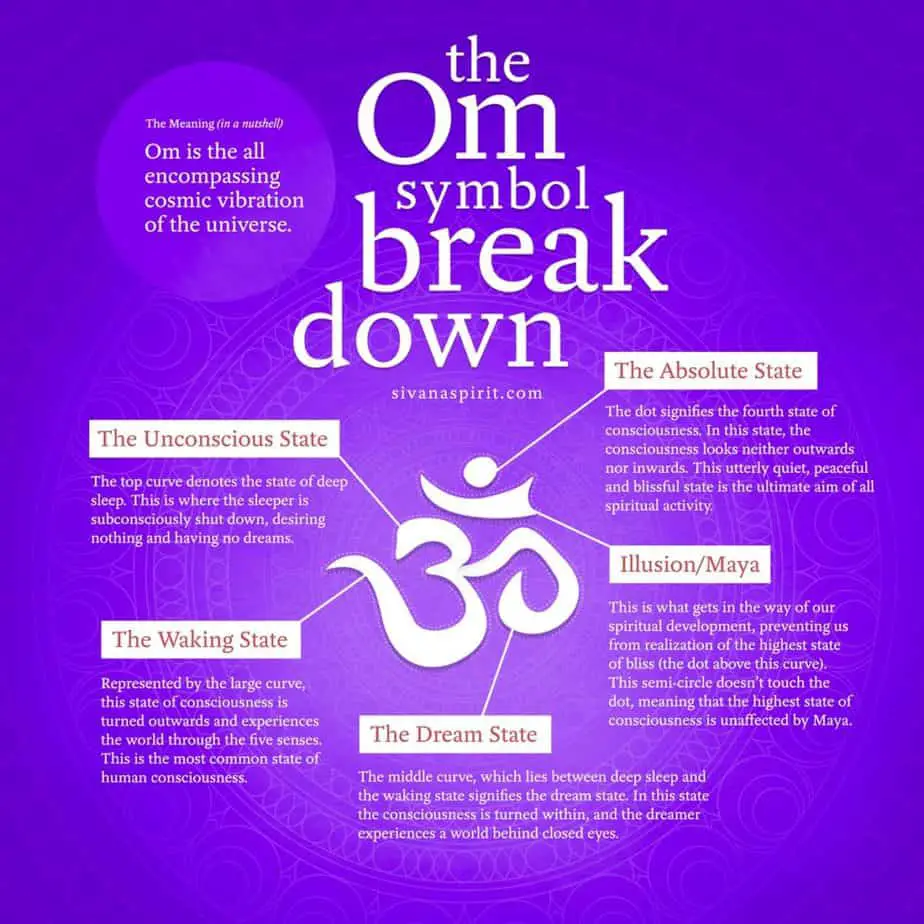
Om Represents 5 States of Consciousness
1. The Wakefulness State – When Our Consciousness Is Focused Outward
During wakefulness our conscious mind is turned outward towards the external world. We are fully aware of both time and space. Often this state is referred to as the “mundane” or “bodily” level.
2. The Dream State (Including Day-Dreaming) – When Our Consciousness is Focused Inward
When we dream, time and space start to become warped. A dream might feel like 1,000 years or 10 minutes. This is an inwardly directed state based on impressions from the external world that you have experienced during the wakeful state.
3. Unconscious Deep Sleep – When We’re Unconscious
In deep sleep there is no perception of time or space. We are completely unconscious, and can only be aware of having been in this state by realizing so afterwards.
Accessing unconscious deep sleep is essential for physical, mental, and spiritual health.
4. Maya – The Illusion of Reality (Ego State)
Ego distorts our understanding of reality. Someone with a large ego might run away from a fight, only to make an excuse that they thought they heard someone call their name. This is the false version of reality that they tell themselves to avoid the pain of accepting the real reality and damaging their fragile ego in the process.
Your ego can distort your version of reality. But no matter how much your ego distorts your personal view on reality, the real version of reality never goes away.
Maya is seen as a lesser-reality-lens superimposed on the real version of reality.
In order to reach pure consciousness one must let go of their ego. Or go through an experience called Ego Death (which I’ve personally experienced and it’s not what you think).
5. Pure Consciousness (commonly known as Turiya)
Turiya is the superconscious state. There is no time and no space. This state lacks wakefulness, sleeping, conscious or unconscious, inward or outward, aware or unaware, and is all of it and none of it at the same time.
Just oneness of being.
Thinking of it another way, pure consciousness is all of the previous 3 states combined. Without this combination of awareness and unconsciousness, Turiya is not possible.
To sum it up, the Om symbol represents the universe, our place with-in it, and our connection to it.
2. The Chakra Symbols
The chakras are another common symbol seen in yoga studios, meditation rooms, and as spiritual tattoos.
The Chakra’s go hand-in-hand with the Om symbol, and Just like Om, the chakras were also described in the ancient Vedas texts.
According to Dr. Georg Feuerstein the chakras are described in ancient texts as Nadis, which translates to “Energy carrying Arteries”
Experts now know that chakras are not specifically a physical organ, but they represent and directly correspond to specific glands in your endocrine system, and also specific nerve clusters in your central nervous system.
Chakra’s are an ancient representation for our internal glands.
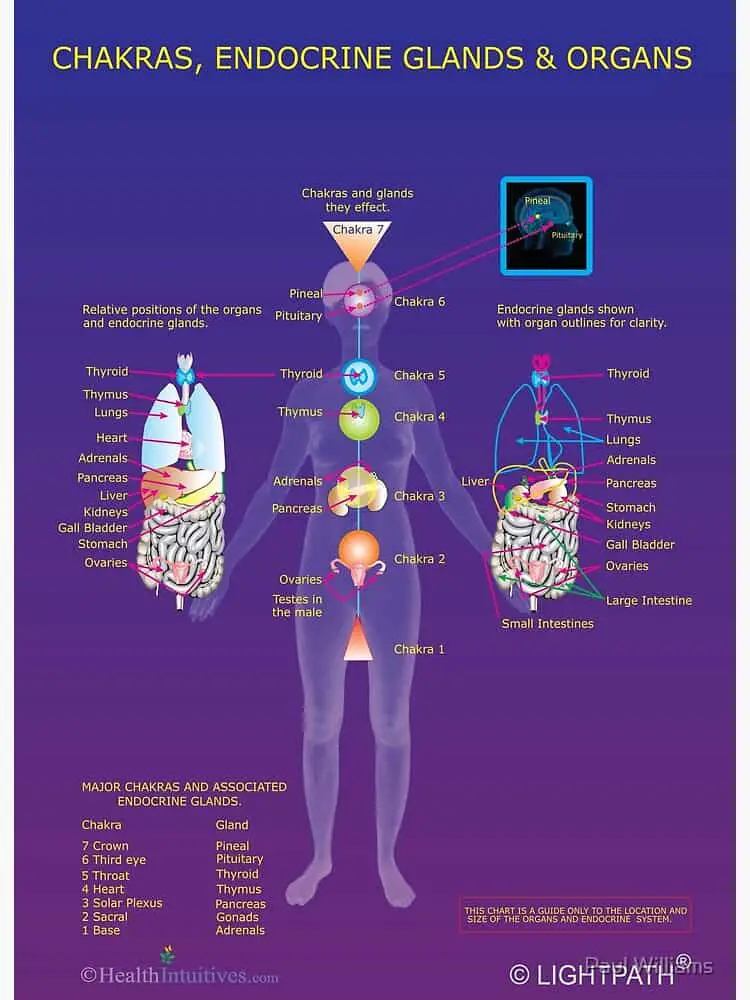
Each of the seven main Chakras are directly associated with the seven endocrine glands as well as corresponding nerve clusters.
Each gland secretes chemical hormones which has a specific effect on certain emotions and organs. This is why there is a direct link from each “chakra location” to a specific emotional or health issue.
If someone says your chakras are “out of balance” what they really mean is that your emotional state is causing a chemical imbalance in your endocrine system.
3. The Number 108
The number 108 is one of those unique numbers, like the Fibonacci sequence and pi, that comes up in mathematics equations related to the universe.
In yoga, 108 is considered a sacred and spiritual number, but why ?
Much like the om (namaste) symbol, yoga, and the chakras, the number 108 also appears in The Ancient Vedas scriptures. The Vedas describe the number 108 as a representation of the whole universe and all existence.
In fact there are exactly 108 sections to the ancient Vedas texts (these 108 sections are known as Upanishads) .
Examples of the Significance of The Number 108
– 108 From a Cosmic Perspective
From a cosmic perspective, there are 27 constellations in our galaxy and each constellation has 4 directions. 27 x 4 = 108. From this perspective, the number 108 encompasses the whole galaxy.
– 108 From The Earth’s Perspective

The distance between the Earth and the Sun is 108 times the diameter of the Earth.
The distance between the Earth and Moon is 108 times the diameter of the Moon.
The diameter of the Sun is 108 times the diameter of the Earth.
Could be a coincidence, but interesting none-the-less.
– 108 & Ancient Monuments
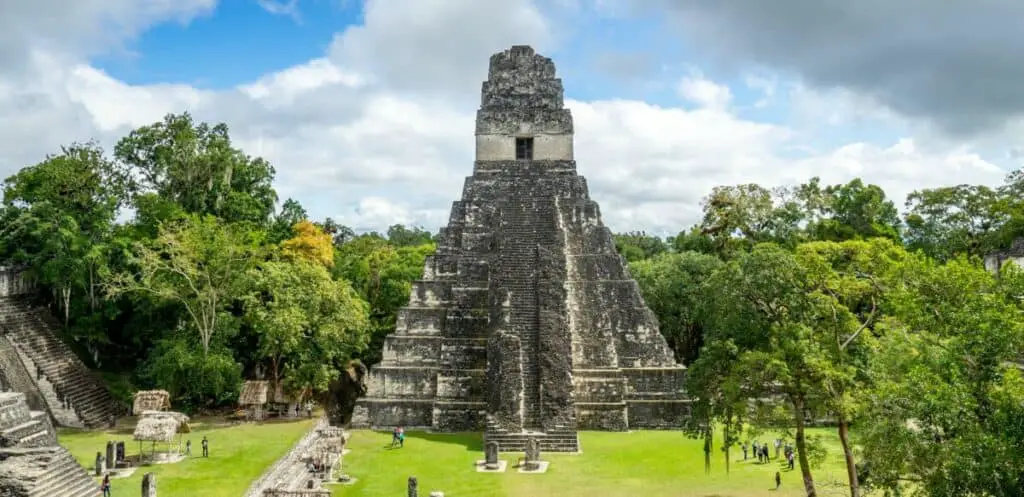
Stonehenge, a prehistoric monument in England is 108 feet in diameter.
In Baliz, the ancient Mayan temple of Lamanai was erected at 108 feet tall. Also, the ancient Mayan funerary Tikal temple in Guatemala is also 108 feet tall.
In India, and according to yogic tradition, there are a total of 108 sacred sites erected which are known as Pithas.
– 108 Marma Points –
The ancient technique of marma point therapy uses massaging techniques on 108 energy points located on the human body.
This massaging technique is described as a way for improving your biochemistry. It’s believed to release stagnant energy and stimulate your internal organs, hormones, and other chemicals to help meet the needs of your body.
– 108 feelings
Buddhist believe that humans have 108 feelings calculated as follows:
6 Senses (Smell, Touch, Taste, Sight, Hearing and Consciousness)
x 3 Pleasant, Painful or Neutral feelings
x 2 Internally or externally generated feelings
x 3 Past, Present or Future feelings
Therefore, 36 past, 36 present and 36 future feelings = 108 total human feelings.
– 108 Beads on a Mala
A mala is a beaded meditation necklace originally thought to be from India and consisting of 108 prayer beads. The mala is similar to the rosary in the Christian religion.

– 108 Yoga Poses
Sun salutations are an ancient yoga routine often performed in nine rounds of the 12 postures which totals 108 poses. 12 poses for each planet and one for the sun.
In 2015 a study found that practicing this routine in college students lead to a greater ability to physically relax and have greater mental clarity.
– 108 From A Mathematical Perspective
Why exactly does this number show up and what does it mean may very well be unclear to even the most seasoned scholars.
Here’s what we know for sure.
There are certain patterns (called fractals) that show up in mathematical codes all over the universe. For example, the swirl of a galaxy, the swirl of a hurricane, and the swirl of a snail shell.
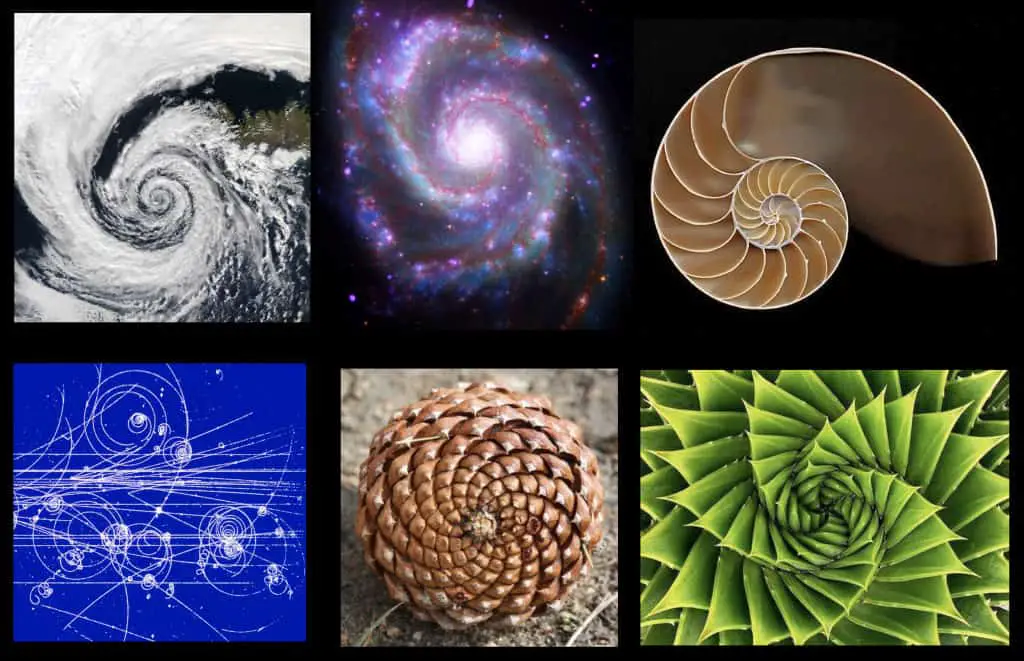
These are all vastly different objects in scale and size, but the ratio’s and proportions of the swirl pattern and structure are all the exact same. This ratio is known as the golden ratio, also known as the Fibonacci sequence.
The Fibinocci Sequence and the number 108–
The Fibonacci Sequence is comprised of a series of numbers which make up a spiral pattern and a series of rectangular ratios in perfect proportion to one another.
For example, using the fibonacci sequence below, 5 is to 8, as 8 is to 13. And 13 is to 21 as 21 is to 34, and so on….This ratio is called the golden ratio, and it an be seen in ancient architecture across the world. For example, the Eiffel tower, Great Pyramid, And the Parthenon in Greece.
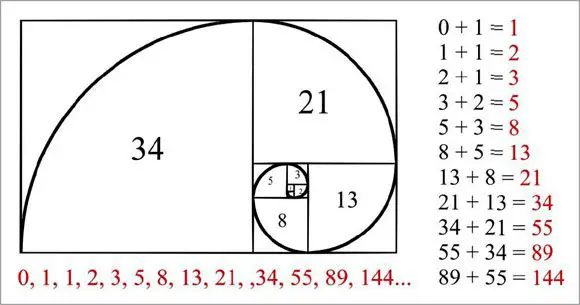
This may not make sense to everyone, but from a mathematical perspective, the chord formed by a 108 degree arch matches the pattern of the golden ratio perfectly.
4. The Lotus Flower Symbol
The lotus flower is one of the most popular and recognizable yoga and meditation symbols. Just about every yoga studio has some variation of the lotus flower design…. But why ?
Well, much like most ancient symbols, the lotus flower has a few different meanings.
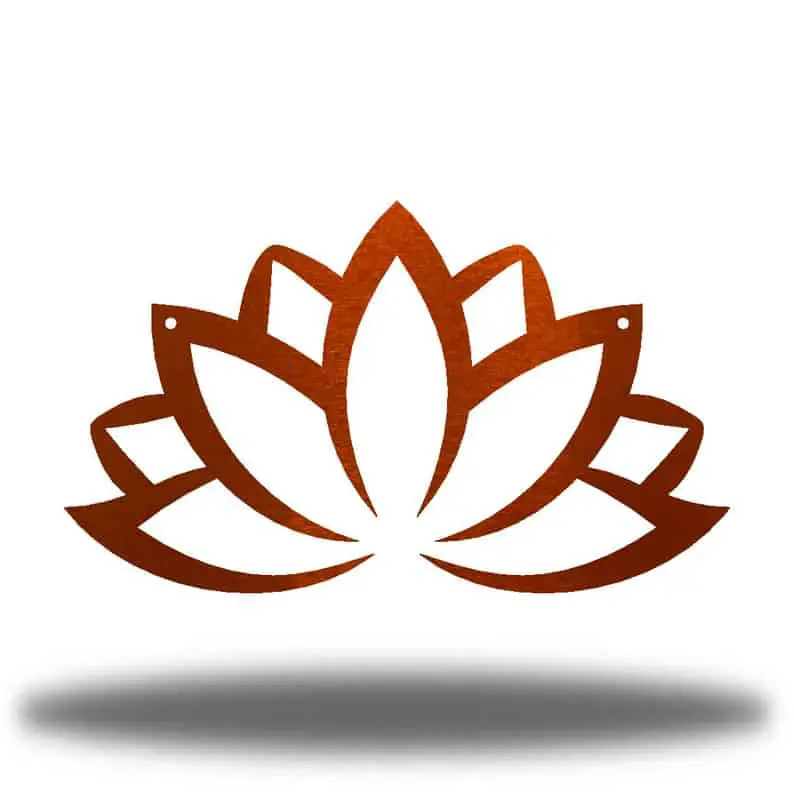
The lotus flower starts is life stuck in the muck of dirty water, murky swamps, and slow-flowing river deltas. But despite their less than ideal origin (mud, muck, and filth) the lotus flower eventually grows out of the muck and blooms into one of the most iconic and beautiful flowers on the planet.
In ancient words and still today, the journey of the blossoming lotus flower is seen as a metaphor for life.
The lotus flower starts with its roots imbedded into the murky bottoms of muddy waters. From there it grows upwards through the water and eventually blossoming into a pure and beautiful flower as it raises above the water into the sunlight.
The lotus flower is the perfect metaphor for personal growth and evolution through life.
For a complete and more in depth breakdown about the The Lotus Flower’s True Origin & Deeper Meanings check out another article we wrote here.
5. The Symbolism of Buddha Himself
The buddha symbol represents the story of Buddha, a prince who gave up his royal luxuries to pursue a life of simplicity and happiness.
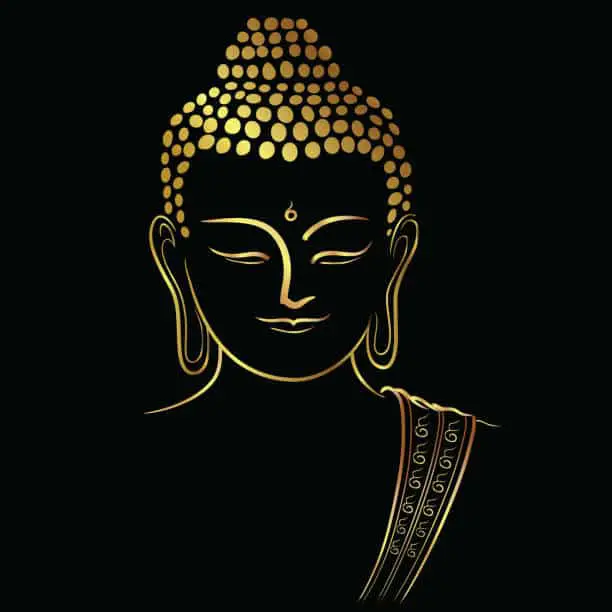
The original Sanskrit meaning of “Buddha” is translated to “the enlightened one”. The buddha symbol reminds us of someone who is wise, compassionate, loving, and with a high set of morals. All principles of buddhism and of yoga.
The 3 Pillars of the Buddha Symbol.
- Virtue, good conduct, and morality.
The principle of equality: that all living entities are equal. Do unto others as you would wish them to do unto you. - Concentration, meditation, mental development.
Developing one’s mind is the path to wisdom which, in turn, leads to personal freedom. Mental development also strengthens and controls our mind; this helps us maintain good conduct. - Discernment, insight, wisdom, enlightenment.
This is the real heart of Buddhism. Wisdom will emerge if your mind is pure and calm.
6. Namaste
If you’ve ever been to a yoga class then you’ve heard the term namaste. At the end of Yoga class, Yoga instructors typically bow their heads towards the class, and say the word “Namaste”. To which the class responds by bowing their heads and repeating, “Namaste”, back to the instructor.
So what does namaste actually mean ?

Namaste comes from Hindu origin and quite literally means “I bow to you”.
But namaste is not a concession of power or a means of cowering, namaste is a sign of mutual respect. It’s an acknowledgement that your ‘higher self’ is recognizing and respecting someone else’s ‘higher self’.
The typical ‘namaste pose’ with hands centered together and head slightly bowed has been found in ancient figures dating back 4,000-5,000 years ago in Ancient India.
7. The Eyes of Buddha
The eyes of Buddha also known as “Wisdom Eyes” are a symbol of buddhism originating from Nepal, and the “Tibetan Buddhists”. But much like traditional Buddhism, the Om symbol, and yoga, the buddha eyes symbol has now spread worldwide and is commonly seen in yoga studios across the world.
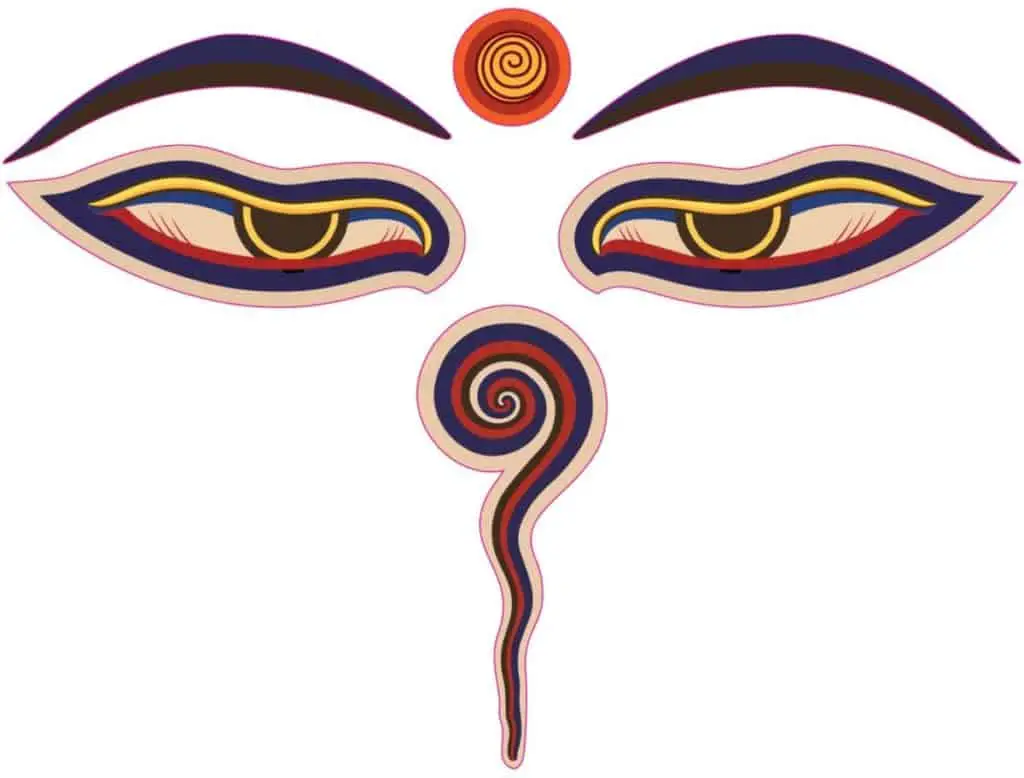
Buddha’s eyes look out into all corners of the universe representing the omnipresence of the all seeing buddha.
There are actually two sets of eyes in the symbol. The middle eye or “third eye” represents the lens through which you look internally at yourself with the deep seeded wisdom of buddha.
The larger outer two eyes represent the way in which you see the material world.
Between the Buddha’s eyes where the nose would be is a spiraling symbol that looks like question mark. This is the Nepali character for the number 1, which symbolizes unity of all the things and the oneness of the universe.
8. The Hamsa Hand
The origins of the Hamsa hand are difficult to pin down, but as presented by Dr. Nafisa Ali Sayed, evidence has been uncovered that dates all the way back to the Phoenician Civilization in Carthage (modern-day Tunisia) around 800 BC. The Phoenicians closely associated the Hand of Hamsa with the Goddess Tanit.
Over the course of history, the goddess Tanit’s hand became known as a defensive amulet and a symbol to ward off the evil eye.
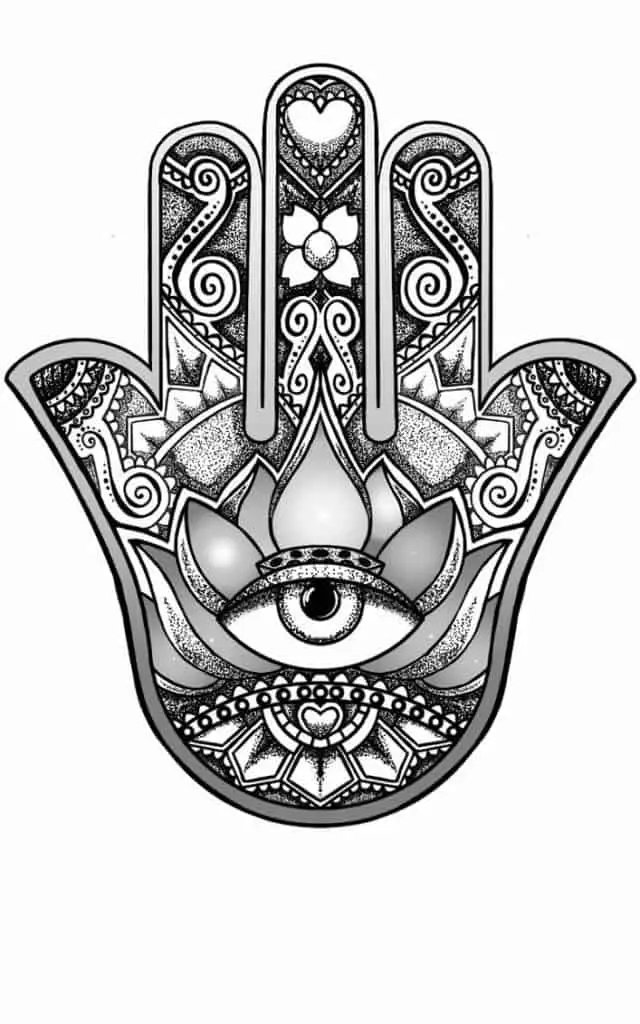
The Hamsa hand has also been found in Ancient Mesopotamia (modern day Iraq).
Since then the Hamsa hand has been adopted by Judaism, Buddhism, Hinduism, Islam, as well as Christianity.
Today the Hamsa hand is know as the “right hand of god” and the hand of Fatima (the daughter of Muhammad)
Despite, being adopted by multiple religions, the overall symbolism and meaning of the hand of Hamsa remains the same. The Hamsa hand Is a symbol used to ward off “the evil eye”.
What The Hamsa Hand Fingers Represent
- Thumb: The solar plexus chakra and fire element
- Forefinger: The heart chakra and air
- Middle finger: The throat chakra and ethereal elements
- Ring finger: The root chakra and earth element
- Pinkie finger: The sacral chakra and water.
9. The Mandala
The mandala is a traditional Hindu symbol (later adopted by Buddha) with its first known appearance found in the Ancient Vedas texts, much like the Om symbol, yoga, the number 108, and the chakras.
So what does the mandala mean and symbolize?
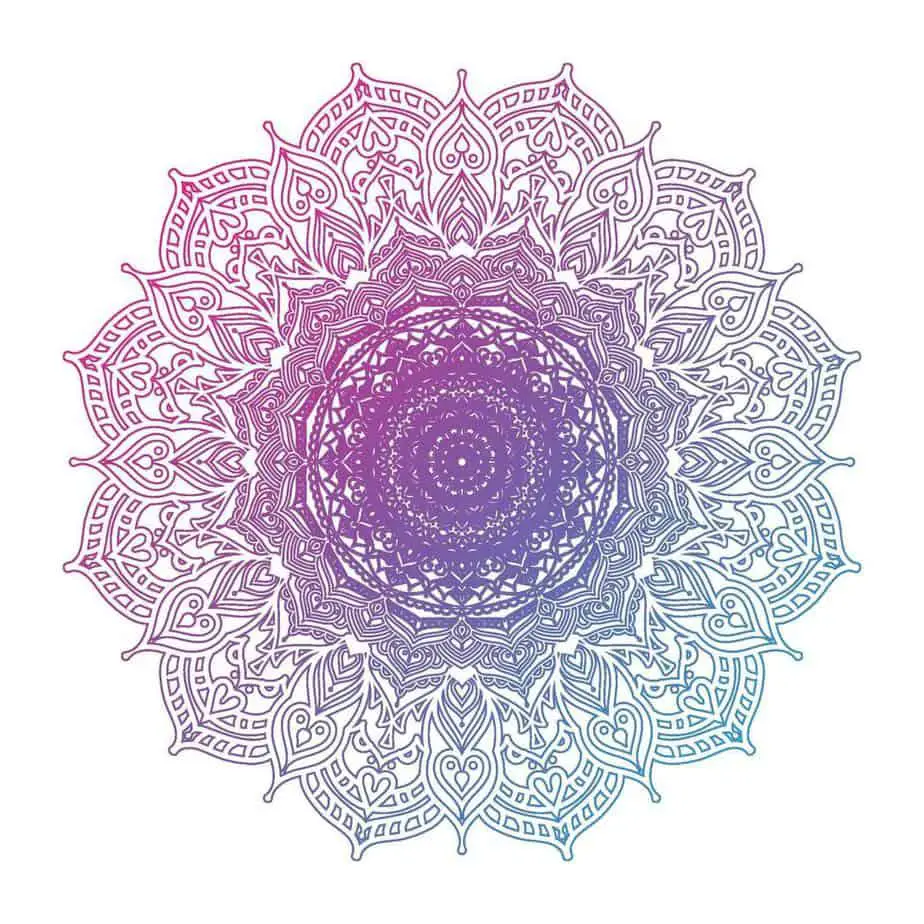
The mandala is a fractal pattern symbol of the cosmos and universe. Most mandalas have colorful, detailed geometric patterns and can be used as a tool to enhance visual meditation.
A traditional mandala is a square containing a circle, although many versions have a multitude of patterns, all mandalas maintain symmetry and stay balanced with a center focal point. That focal point much like Metatrons cube, symbolically represents the singularity from which the universe originates and expands from (ie, the big bang).
Some traditions use mandalas for meditation purposes and for accessing higher levels of consciousness. The mandala is seen as an artistic representation of what higher consciousness might look like, and is used to focus one’s attention through prolonged focus.
10. Ganesh
Ganesh is the Hindu god of wisdom and the lord of good fortune.
Ganesh’s elephant head symbolizes his wisdom and the knowledge that can be gained through listening and reflection.
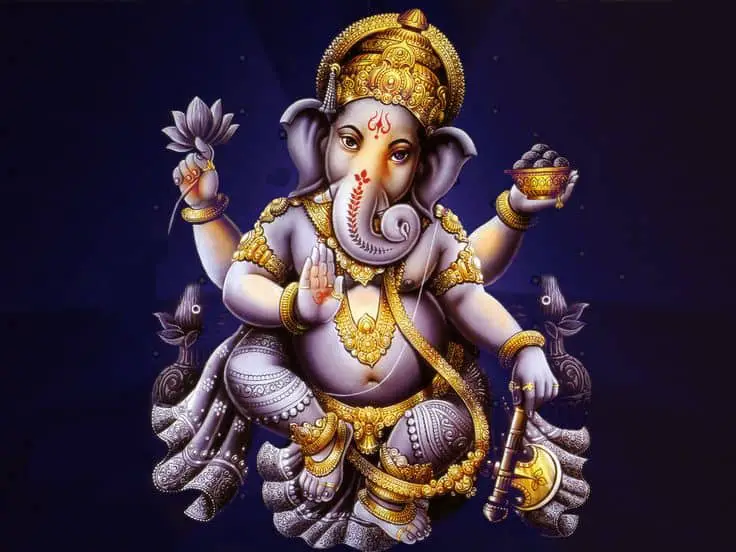
Worship of Ganesh is thought to bring prosperity, success and protection. From the yogic perspective, Ganesh is the supreme administrator of the senses. Ganesh is a symbol for pure universal intelligence.
The intention of admiring Ganesh is to break through our limitations and create personal transformation resulting in a higher consciousness. In yoga, Ganesh is said to be connected to the root chakra, which represents survival and material well-being.
There is also deep symbolism in the elephant form which Ganesh embodies. For more on Elephant symbolism here’s another article we wrote which dives deeper.
11. Shiva
Lord Shiva is considered the “great god” and is the father and founder of Yoga. He is widely celebrated as the very first teacher Yoga.
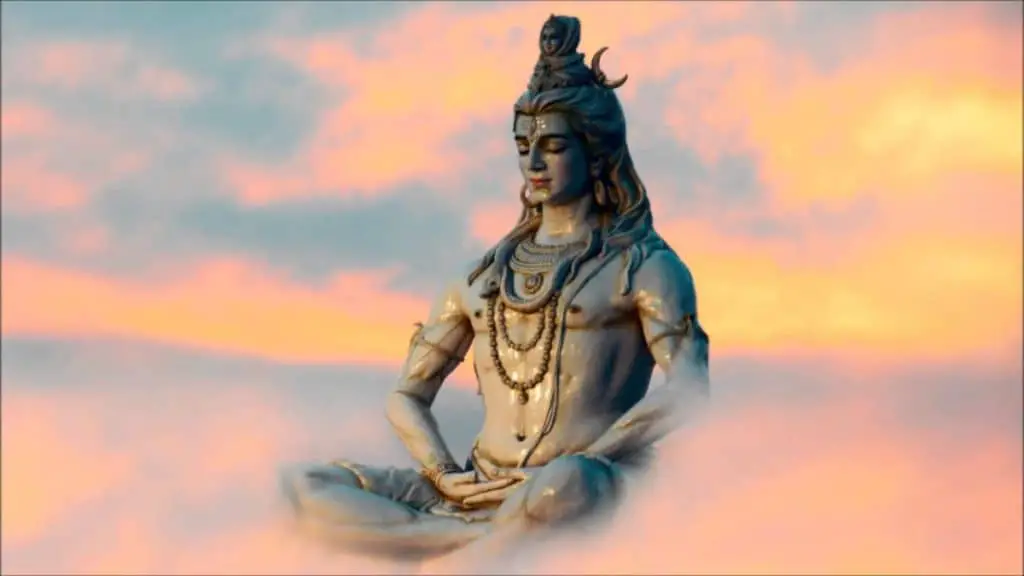
Lord Shiva is often seen meditating in the silence of the mountains sitting in a lotus yoga pose. His conscious energy is said to be so high that he controls the entire functioning of the universe in his subconscious mind.
Shiva is also the father of Ganesh.
12. Yin & Yang
The origins of the ying-yang goes back to 600 B.C. in Ancient China. The ying-yang was first used as a time keeping device which tracked shadow lengths over the course of the year.
Yang represents the winter solstice and indicates the beginning of the period when daylight dominates over darkness. This is why Yang is associated with the sun.
Yin represents the summer solstice and represents the dominance of darkness over daylight. Thus Yin represents the dominance of darkness over daylight and is associated with the moon.
It is this fundamental basis that leads the ying-yang to symbolize light vs. darkness and good vs. evil.
13. The Wheel of Dharma
The wheel of dharma is used heavily in both Hindu and Buddhist belief systems. And with-in both Hinduism and Buddhism there’s multiple interpretations, symbolic representations depending on the context.
The wheel of dharma has 3 basic components that make up the chariot wheel. The center hub, the outside wheel, and the spokes.
Author and Zen Buddhism expert Barbara O’Brien has spent years researching the symbolic meanings of the dharma wheel. And Mrs. O’Brian has found that, over the centuries, the core components of the dharma wheel have taken on their own meanings and symbolism.
The Hub –
The hub of the dharma wheel is often depicted differently over time and in different cultures, sects, religions. Generally, the hub of the dharma wheel is believed to represent moral discipline.
Sometimes the hub is represented by the yin-yang symbol. And sometimes the hub is composed of 3 swirls. The three swirls are said to represent the Three Treasures or Three Jewels of Buddhism
The Rim –
The main circle which gives the ancient symbol its round wheel shape, represents the perfection of the dharma (which is interpreted as the natural laws of nature and the universe). Circular and never ending.
Many historians also believe that the rim of the wheel represents meditation, concentration, and mindfulness, which are key pillars of both Buddhist and Hindu disciplines.
The Spokes –
The number of spokes on the dharma wheel varies over time as the wheel has taken on different meanings in different cultures. Sometimes the wheel’s spokes are contained with-in the circle, and sometimes the spokes protrude beyond the wheel.
It is said that the spokes protruding outside the circle represent penetrating insights which have edges sharp enough to cut through ignorance.
Conclusion
Ancient symbols are mysterious, fascinating, and captivating. In today’s culture, millions of people wear ancient symbols on their clothes and get symbolic tattoos, but not many people truly understand the deep-rooted origins and meanings of these symbols.
From the Om symbol, to the meaning of namaste, to the number 108, to Buddha, to Shiva, tot he depths of the universe and back.
Check Out Our Other Interesting Articles About Symbolism
- The Flower of Life: Symbolism, Meaning & Origin Explored
- The Lotus Flower Meaning | Symbolism & History
- Archangel Metatron’s Cube: History, Origin & Symbolism
- The Namaste Symbol | Om Symbol Meaning | Yoga Symbols
- Tree of Life Symbol: Meaning & Origin
- The Meaning Behind The Freemason Symbol: History & Origin
- The Dharma Wheel Meaning: Origin Explained
- The Ankh (unk) Symbol: Ancient Egyptian Meaning
- Elephant Symbolism & Meaning Explained
- Scarab Beetle Symbolic Meaning | History & Origin
- Symbolism, Meaning, and Origin of The Serpent
- What Are Sacred Geometry Symbols & Meanings
- What Is The Egyptian Eye Of Ra ? Symbolism Explained
- The Eye of Horus vs. The Eye of Ra | Meaning
- What’s Your Third Eye? How To Open It ?
Loved what you read?
Hit that share button and let the world in on the secret – we’d be thrilled!
Got thoughts? We’re all ears for your feedback, corrections, or a good old chat. Don’t be shy; drop us a line.
And hey, don’t miss out on our curated list of must-reads in the recommended books section.
Big thanks for diving in with us today!


